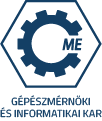| Course objectives: |
| Learning and application to practical design the internal programming possibilities of finite element program systems. The student can select which finite element program system he wants to program (COSMOS/M, ANSYS, ADINA, NX) . Numerical example is given in the beginning of the semester and it will be solved by using programming of a FEM system until the end of the semester. |
| Course content and structure: |
| Short history of computers technique, CAD and finite elements. History and developments of optimization algorithms. Benchmark functions, local optimum, the Shekel- foxholes test function. Evolutionary algorithms, examples (RVA, BFA, AA, GA, PSA optimization algorithms). Introduction of the multidisciplinary optimization, combining finite elements and optimization. Multidisciplinary optimization in machine design. Numerical examples (gear noise, springs, journal bearings, etc). Usage of the internal programming language of some finite element systems (for example ANSYS, COSMOS/M, NX, ADINA, etc.) for multidisciplinary optimization. Detailed listing and analysis of program commands of the program language of the selected finite element system. In practical lessons demonstrations and consultations will be concerning the programming of FEM systems, example programs demostrated. |
| Evaluation method: |
| Test containing ten questions concerning the topics shown during the lectures and practical lessons. The maximum possible points of the test is 100. The exam will be closed by a 5- grade mark. Points 0-39: failed (1); points 40-54: passed (2); points 55-69: average (3); points 70-84: good (4); points 85-100: outstanding (5). For the signature it is necessary to solve the programming example given in the beginning of the semester at least 90% ready. |
| Required reading: |
| ANSYS Inc.; SAS IP Inc. (2011): ANSYS Mechanical APDL Technology Demonstration Guide, Southpointe, 275 Technology Drive, Canonsburg, PA 15137, USA. Szabó, F. J.: Multidisciplinary optimization of a structure with temperature dependent material characteristics, subjected to impact loading. International Review of Mechanical Engineering, 2 (3) pp. 499- 505. (2008). SRAC: COSMOS/M User Guide. Santa Monica, CA. USA.1995. |
| Suggested reading: |
| Martin, H. C. ; Carey, G. F.: Introduction to Finite element analysis, Theory and application. McGraw-Hill Inc. New, York, 1976. Leu, M. C., Ghazanfari, A., Kolan, K.: NX10 for engineering dsign. SIEMENS and Missouri University of Science and Technology, Parker Hall, Rolla, MO, USA, 2017. |


